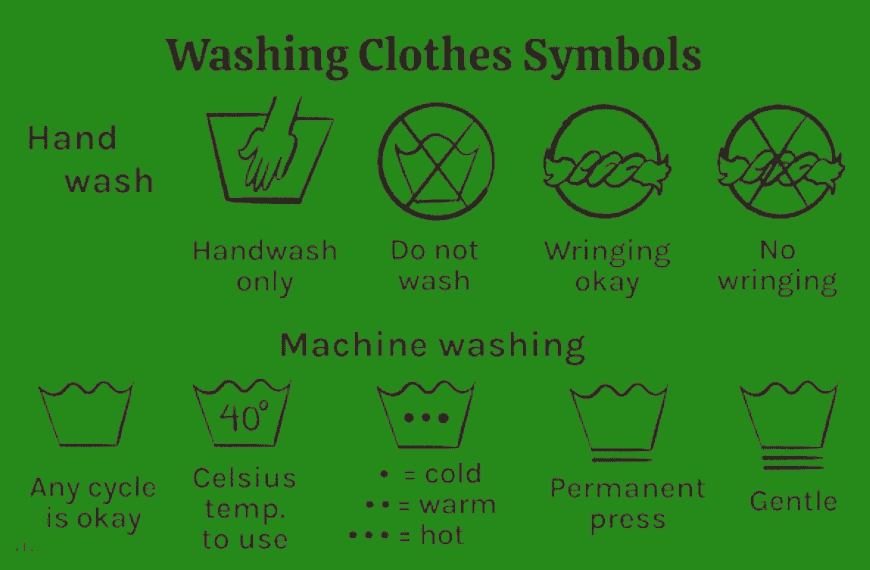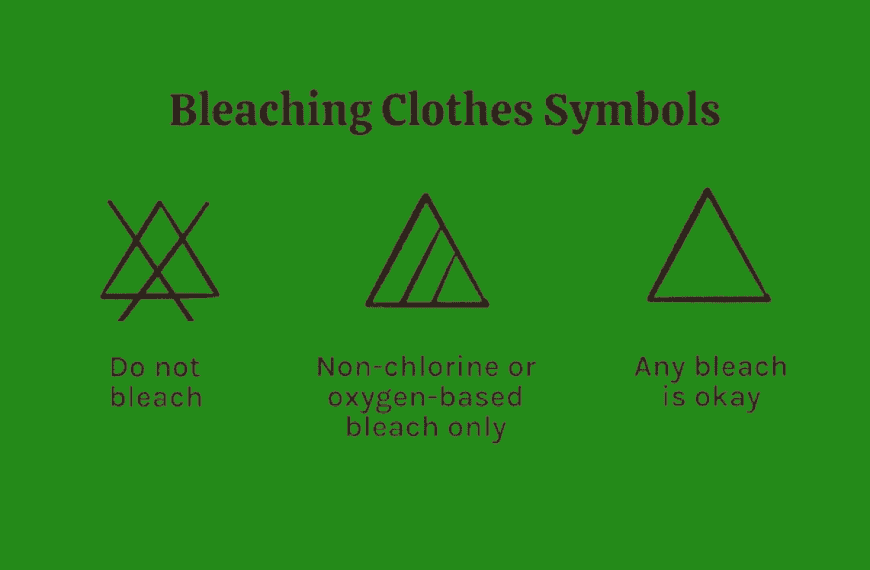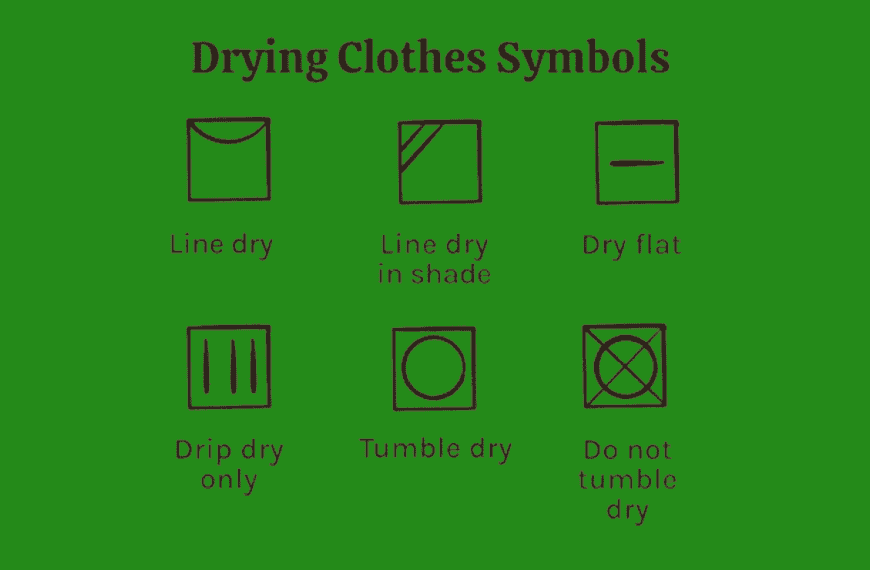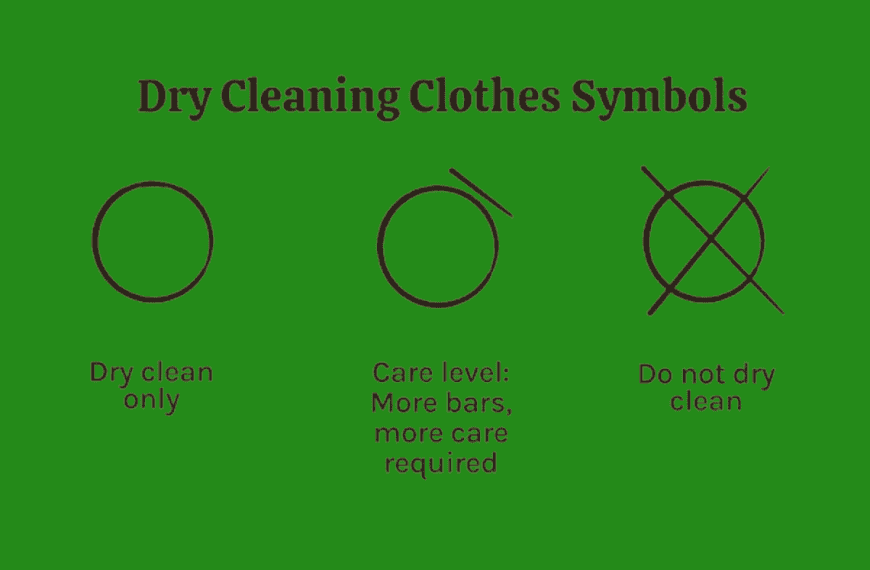Laundry symbols may seem like a mysterious code, but they are essential for maintaining the quality and longevity of your clothing. These symbols provide specific care instructions designed to keep garments looking their best and functioning properly over time. By following these symbols, you can prevent common laundry mishaps such as shrinking, fading, or fabric damage, ensuring your clothes stay in top condition.
Understanding laundry symbols is crucial not only for preserving your clothing but also for saving time and money. Proper care can reduce the need for costly repairs or replacements, and it ensures that your wardrobe remains in excellent shape. In this guide, we’ll break down the various types of laundry symbols you’ll encounter, making it easier for you to interpret and apply them effectively.
We will cover four main categories of symbols:
- Washing Symbols: These provide instructions on the temperature and method of washing, including whether to use a machine or hand wash the garment.
- Drying Symbols: These indicate how to dry your clothes, detailing methods such as tumble drying or air drying, and the appropriate heat settings if using a dryer.
- Ironing Symbols: These specify the correct heat levels for ironing and whether to use steam or avoid ironing altogether.
- Bleaching Symbols: These show whether bleach can be used, and if so, what type of bleach is appropriate for the garment.
How to Wash Clothes Symbols

Washing symbols on clothing labels provide crucial instructions to help you clean your garments properly without causing damage. Understanding these symbols ensures that you choose the correct washing method and settings, preserving the quality and extending the life of your clothes. Here’s a detailed guide to decoding the various washing symbols you might encounter:
- Water Temperature Symbols
- Hot Water Symbol: This is usually depicted as a tub with a single dot inside and a temperature range, such as 60°C or 140°F. Hot water is typically used for whites and heavily soiled items but may cause some fabrics to shrink or fade.
- Warm Water Symbol: Represented by a tub with two dots inside, this indicates a moderate temperature range, such as 40°C or 104°F.
- Cold Water Symbol: Shown as a tub with three dots, this symbol suggests washing with cold water, usually below 30°C or 86°F. Cold water helps prevent colors from bleeding and is gentle on delicate fabrics.
- Washing Method Symbols
- Machine Wash Symbol: A simple tub icon with a hand indicates that the garment can be machine washed. The presence of a number inside the tub (e.g., 30, 40, 60) specifies the maximum temperature.
- Hand Wash Symbol: Depicted as a hand in a tub of water, this symbol means the garment should be washed gently by hand to avoid damage. Use lukewarm water and mild detergent.
- Do Not Wash Symbol: A tub with a cross over it signifies that the item should not be washed with water. This usually means the garment needs professional dry cleaning.
- Washing Cycle Symbols
- Normal Cycle Symbol: Represented by a single line under the tub, this indicates a standard washing cycle suitable for everyday fabrics.
- Gentle Cycle Symbol: Depicted as a tub with a hand or a circle inside, this symbol signifies a delicate cycle with less agitation, ideal for fragile fabrics.
- Delicate Cycle Symbol: Shown as a circle inside the tub, this symbol indicates the need for a very gentle wash, often used for items that are prone to damage.
- Other Important Symbols
- Bleach Symbol: A triangle with a “CL” inside signifies that bleach can be used during the wash.
- Do Not Wring Symbol: This symbol, usually a hand wringing a piece of cloth with a cross over it, indicates that the garment should not be wrung out, as this can cause stretching or distortion.
How to Bleach Clothes Symbols

Bleaching symbols on clothing labels provide essential instructions for safely using bleach in the laundry. Proper interpretation of these symbols helps prevent damage to your garments and ensures that you use bleach effectively. Here’s a detailed guide to understanding the various bleach symbols you may encounter:
- Bleach Allowed Symbols
- Triangle with a “CL” Inside: This symbol indicates that chlorine bleach can be used on the garment. It is typically used for whitening and removing stubborn stains. Ensure that you follow the recommended bleach dilution and application instructions to avoid damaging the fabric.
- Triangle with No “CL” Inside: Sometimes, a triangle without any letters means that oxygen bleach (also known as non-chlorine bleach) is suitable. This type of bleach is gentler and often used for colored fabrics to avoid fading.
- No Bleach Symbols
- Triangle with a Cross Over It: This symbol, showing a triangle with a diagonal cross, means that bleach should not be used on the garment. Using bleach on these items could cause discoloration, weakening, or other damage. Stick to non-bleach alternatives if you need to address stains or whitening.
- Do Not Bleach Symbol: Often accompanied by the words “Do Not Bleach” or a crossed-out triangle, this symbol reinforces that bleach is not safe for use with the garment. Follow alternative cleaning methods recommended for such items.
- Special Instructions for Bleaching
- Use Only Non-Chlorine Bleach: Some labels may specify that only non-chlorine bleach can be used, indicated by a triangle with a “CL” and a line through it or by the words “Only Non-Chlorine Bleach.” Non-chlorine bleach is milder and suitable for color-safe whitening.
- Dilution Instructions: Occasionally, the label will provide specific dilution instructions or ratios for bleach use. This helps ensure that bleach is used safely and effectively, reducing the risk of fabric damage.
- Additional Tips for Using Bleach
- Test for Colorfastness: Before using bleach on any garment, especially if the label permits it, test a small, inconspicuous area to check for colorfastness. This helps prevent unwanted discoloration.
- Follow Manufacturer’s Instructions: Always adhere to the manufacturer’s recommendations regarding bleach use, including proper dilution, soaking times, and washing conditions, to ensure the best results and garment care.
How to Dry Clothes Symbols

Drying symbols on clothing labels provide critical instructions on how to properly dry your garments to avoid damage and maintain their quality. Understanding these symbols helps ensure that your clothes are dried in the appropriate manner and at the correct temperature. Here’s a comprehensive guide to interpreting the various drying symbols you might encounter:
- Drying Methods
- Tumble Dry Symbol: Depicted as a square with a circle inside, this symbol indicates that the garment can be dried in a tumble dryer. Inside the circle, there may be dots to denote heat settings:
- One Dot: Low heat, suitable for delicate fabrics.
- Two Dots: Medium heat, appropriate for most everyday fabrics.
- Three Dots: High heat, used for durable fabrics like towels and sheets.
- Do Not Tumble Dry Symbol: Shown as a square with a circle inside and a cross over it, this symbol means that the garment should not be dried in a tumble dryer. Instead, it should be air-dried or dried using alternative methods.
- Line Dry Symbol: Represented by a square with a horizontal line at the top, this indicates that the garment should be hung up to dry. This method is often used for delicate items that might get damaged in a dryer.
- Drip Dry Symbol: Illustrated as a square with three vertical lines at the top, this symbol means the garment should be hung to dry while it drips, usually in a shaded or well-ventilated area to prevent color fading or fabric distortion.
- Dry Flat Symbol: Shown as a square with a horizontal line in the middle, this symbol indicates that the garment should be laid flat to dry. This method helps maintain the shape and prevent stretching, especially for items made of delicate or stretchy fabrics.
- Tumble Dry Symbol: Depicted as a square with a circle inside, this symbol indicates that the garment can be dried in a tumble dryer. Inside the circle, there may be dots to denote heat settings:
- Heat Settings for Tumble Drying
- Low Heat Symbol: A single dot inside the tumble dryer circle indicates a low heat setting. This is ideal for delicate fabrics that may shrink or become damaged at higher temperatures.
- Medium Heat Symbol: Two dots inside the circle denote a medium heat setting. Suitable for most common fabrics, this setting balances effective drying with minimal risk of heat damage.
- High Heat Symbol: Three dots inside the circle represent a high heat setting, appropriate for sturdier fabrics like cotton towels and bed linens.
- Special Instructions
- Do Not Wring Symbol: Often depicted as a hand wringing out a cloth with a cross over it, this symbol indicates that the garment should not be wrung out before drying. Wringing can cause stretching or distortion, particularly in delicate fabrics.
- Remove Promptly Symbol: Sometimes indicated by a clock or specific time recommendation, this symbol advises removing the garment from the dryer promptly to minimize wrinkles and maintain the garment’s shape.
- Additional Tips for Drying Clothes
- Check for Residual Moisture: Ensure that garments are thoroughly dried to prevent mildew or odors, especially if air-drying. Check for residual moisture before storing.
- Avoid Overloading the Dryer: When using a tumble dryer, avoid overloading it to ensure even drying and to prevent excessive wrinkling or damage to the clothes.
How to Iron Clothes Symbols

Ironing symbols on clothing labels offer guidance on how to properly press and care for your garments. Understanding these symbols helps prevent damage and ensures that your clothes are ironed at the correct temperature and with the appropriate technique. Here’s a detailed guide to interpreting the various ironing symbols you may encounter:
- Ironing Temperature Symbols
- High Heat Symbol: Depicted as an iron with three dots inside, this symbol indicates that the garment can be ironed at a high temperature, suitable for durable fabrics such as cotton and linen.
- Medium Heat Symbol: Shown as an iron with two dots, this symbol advises ironing at a medium temperature. This is appropriate for most everyday fabrics like polyester blends and some synthetic materials.
- Low Heat Symbol: Illustrated as an iron with one dot, this symbol suggests using a low temperature for ironing. This setting is ideal for delicate fabrics such as silk and polyester that are prone to heat damage.
- Steam vs. No Steam Symbols
- Steam Iron Symbol: Represented by an iron with steam lines coming out of it, this indicates that using steam while ironing is suitable. Steam helps in easing out wrinkles and can be used on most fabrics, but be cautious with delicate materials.
- No Steam Symbol: Shown as an iron without steam lines, this symbol advises against using steam while ironing. It is typically used for fabrics that could be damaged by moisture, such as wool or some synthetics.
- Ironing Instructions for Specific Fabrics
- Iron While Damp Symbol: Depicted by an iron over a droplet, this symbol suggests ironing the garment while it is still slightly damp. This technique can help smooth out wrinkles more easily.
- Iron on Reverse Side Symbol: Shown as an iron with a fabric icon facing the opposite direction, this symbol recommends ironing the garment inside out to protect the outer fabric from shine or damage.
- Ironing Restrictions
- Do Not Iron Symbol: Represented by an iron with a cross over it, this symbol indicates that the garment should not be ironed. This is usually the case for items made from materials that could be damaged by heat, such as certain plastics or delicate fabrics.
- Iron with Caution Symbol: Sometimes depicted with an iron and an exclamation mark, this symbol suggests that ironing should be done with care, possibly at a lower temperature or with protective measures like a pressing cloth.
- Additional Tips for Ironing Clothes
- Use a Pressing Cloth: For delicate or prone-to-shine fabrics, use a pressing cloth between the iron and the garment to protect the fabric.
- Adjust Iron Settings: Always adjust the iron settings according to the fabric type to avoid damage. Check the care label for specific temperature recommendations and other instructions.
By understanding and following these ironing symbols, you can effectively press your garments while maintaining their appearance and fabric integrity. Each symbol provides precise instructions on temperature settings and techniques, helping you avoid common ironing mistakes and ensure that your clothes look their best.
How to Dry Clean Clothes Symbols

Dry cleaning symbols on clothing labels offer essential guidance for properly cleaning garments that require special care beyond standard washing and drying methods. Understanding these symbols helps ensure that your clothes are cleaned correctly and remain in excellent condition. Here’s a comprehensive guide to interpreting the various dry cleaning symbols you may encounter:
- Dry Cleaning Symbols
- Circle Symbol: The basic dry cleaning symbol is a circle. This indicates that the garment should be dry cleaned. It’s a catch-all symbol for garments that require professional cleaning to avoid damage from water or standard laundry detergents.
- Professional Cleaning Symbols
- Circle with a Letter (P or F): Inside the dry cleaning circle, you may see a letter:
- P: This letter indicates that the garment can be cleaned with perchloroethylene, a common solvent used in dry cleaning.
- F: This letter means the garment should be cleaned with a hydrocarbon solvent, a gentler alternative to perchloroethylene.
- Circle with a Letter (P or F): Inside the dry cleaning circle, you may see a letter:
- Do Not Dry Clean Symbols
- Circle with a Cross Over It: Depicted as a circle with a diagonal cross, this symbol means that the garment should not be dry cleaned. Instead, it might need to be washed by hand, machine washed, or cleaned through other specified methods.
- Special Dry Cleaning Instructions
- Circle with a Letter and Additional Symbols: Sometimes, the dry cleaning circle will include additional symbols or letters:
- A Circle with a “W”: Indicates that wet cleaning, a professional water-based cleaning process, is acceptable.
- Circle with a “P” and a Line Underneath: This symbol advises that only certain types of solvent (usually less aggressive) should be used during dry cleaning.
- Circle with a “F” and a “W”: This symbol suggests that the garment should be cleaned with a combination of solvents or processes, such as a special method used for sensitive fabrics.
- Circle with a Letter and Additional Symbols: Sometimes, the dry cleaning circle will include additional symbols or letters:
- Additional Care Symbols
- Do Not Steam or Iron Symbol: Sometimes, the label will include a warning against steam or ironing after dry cleaning. This is usually depicted by an iron with a line through it or a steaming icon with a cross. This instruction helps prevent damage from heat or moisture.
- Handling Recommendations
- Handle with Care Symbol: Sometimes a garment will have an additional note or symbol indicating that it should be handled with care during dry cleaning. This might be shown by a hand icon or text specifying gentle handling.
- Important Tips for Dry Cleaning
- Always Follow Label Instructions: Adhering to the care label is crucial for maintaining the garment’s quality. Each garment may have specific requirements based on its fabric and construction.
- Inform the Dry Cleaner: If your garment has any special features, such as embellishments or delicate fabrics, inform the dry cleaner to ensure appropriate care is taken.
By understanding and following these dry cleaning symbols, you can ensure that your garments receive the professional care they need while avoiding potential damage. Each symbol provides specific instructions that help maintain the appearance and longevity of your clothes, making it easier to manage your wardrobe with confidence.
Read more : How to Laundry Stripping with Tru Earth Laundry Strips
